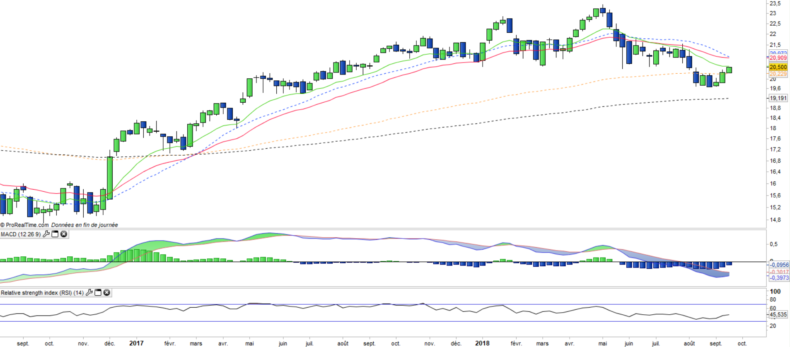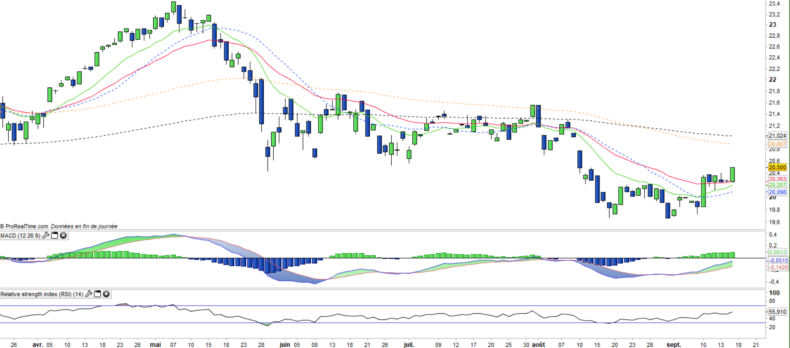Lyxor ETF FTSE MIB - MIB - 18/09/2018
Short Term strategy: Negative (20%) / trend +
Long Term strategy: Neutral (50%) / trend =
Characteristics of the ETF
The ETF MIB (Lyxor FTSE MIB40) created in 11/2003, listed in Euro on Euronext, replicates the Italian national index, composed of the 40 main Italian securities. The composition of the index is determined on the basis of three criteria: free float, liquidity and the representativeness of the main sectors of the Italian market.
The ETF MIB charges are 0.35%, and the AUM is approximately €519M. Replication is indirect (via swap) and there is a dividend distribution policy.
Alternative ETFs: EWI (iShares USD), IMIB (iShares in Euro)
Latest developments
In 2017, the index posted an increase of 13.6% (against 10.6% for the stoxx600NR) and fell by -3.8% in 2018, which is mainly in the banking sector (Unicredit and San Paolo are down respectively from -10% and -7% since the beginning of the year). T
he cause is above all political and linked to the populist program of the new government which is fearing a slippage of public finances and a crisis with Brussels may initiate an exit from the Euro zone. While the latest statements by the finance minister are rather reassuring, the markets are nevertheless very anxiously awaiting the presentation of the Italian budget in the autumn. More than the trade war in which the crisis of the emerging, the Italian policy seems to be the main factor likely to condition the evolution of the European markets in the coming weeks, because it has the potential to reactivate a crisis of the Euro zone in the eyes of the investors.
Index & components
This index has the particularity of being very overweight in financials which represent more than one third (36%) of its composition (against about 20% for the stoxx600), including Intesa San Paolo, Unicredit and Generali while the energy is also a significant weight (18%) via ENI and Saipem, the other important sectors are cyclical consumer goods (16%) and utilities (14%), among which are Enel, SNAM and Atlantia. The 10 largest caps represent just over two-thirds of the index.
The Italian index is very volatile, given the importance of cyclical and financial sectors and the structural weakness of the Italian economy due to lack of growth, high unemployment and huge debt (134% of GDP) which worries the markets regularly.
The Italian economy has been hit hard by the financial crisis: it has contracted by more than 9% since 2007 and has faced 13 quarters of recession. Although the Italian economy has emerged from the recession since 2015, growth remains below the Italian government expectations and the euro area average. In 2016 the country was hit by two earthquakes and the arrival of 170,000 migrants on its territory which led to a major humanitarian crisis.
Italy made good progress in its banking restructuring in 2017 with the rescue of state-owned banks and the takeover of assets by Intesa Sanpaolo, which followed the rescue of BMPS, as well as the refinancing of Unicredit for 13bn€ in the first quarter of 2017. Overall, the structural factors (banking system reforms and labor flexibility) are taking shape, and the business cycle is accelerating.
The election of a populist government fuels fears of a potential halt to reforms and a possible surge in the budget deficit.
The Euro / USD exchange rate remains a significant factor for the Italian economy driven by exports.
Weekly data
The weekly chart shows a medium-term downtrend that seems to be running out of steam with the beginning of a bottom structure and an outperformance of the index for 3 weeks compared to the Stoxx600NR. However, to confirm the short term reversal, the index will have to cross the level of 21600 pts and cross all the moving averages upward, located in this area. The test should be imminent.
Daily data
On the daily chart, we can see that a short-term reversal is occurring. Prices have exceeded moving averages, and we now need to monitor the upward crossing between EMA13 and 26 that would confirm the signal, which would be an important step towards restoring the long-term positive trend that remains valid, although weakened. The technical oscillators are positive and plead for the continuation of the current rebound.
ETF Objective
MIB is a UCITS ETF, listed in EUR, and which seeks to replicate the FTSE MIB Net Total Return Index (40 italian companies)
Characteristics
| Inception date | 04/11/2003 |
| Expense ratio | 0,35% |
| Benchmark | FTSE MIB40 index |
| Ticker | MIB |
| ISIN | FR0010010827 |
| UCITS | Yes |
| EU-SD status | Out of scope |
| Currency | € |
| Exchange | Euronext Paris |
| PEA (France) | Yes |
| SRD (France) | Yes |
| Dividend | distribution |
| Assets Under Management | 519 M€ |
| Currency Risk | No |
| Number of Holdings | 40 |
| Risk | 4/5 |
Country Breakdown
| Italy | 87% |
| United Kingdom | 8% |
| Netherlands | 3% |
| Luxemburg | 2% |
Sector Breakdown
| Financials | 36% |
| Energy | 18% |
| Consumer discretionary | 16% |
| Utilities | 14% |
| Industrials | 9% |
| Information Technology | 3% |
| Telecom services | 2% |
| Others | 3% |
Top Ten Holdings
| ENI | 12% |
| Enel | 11% |
| Intesa Sanpaolo | 10% |
| Unicredit | 9% |
| Assicurazioni Generali | 6% |
| Fiat Chrysler | 5% |
| Ferrari | 4% |
| STMicroelectronics | 3% |
| CNH Industrial | 3% |
| Atlantia | 3% |


